Wizards & Warriors Preview
Greg Kasavin plays a near-complete build of D.W. Bradley's upcoming RPG and lives to tell the tale.
It may be just as well that a role-playing game that's as expansive as Wizards & Warriors takes so long to produce: When the game's designer, D.W. Bradley, first started the project in the summer of 1996, he had a vision of the game he wanted to make. But he didn't know that achieving it would take him as long as it would. The game is a first-person fantasy epic whose story is even richer than that of its long development. Originally designed as a turn-based multiplayer RPG, Wizards & Warriors now apparently bears little likeness to its original form - however, Bradley insists that the game, in essence, is very similar to his 4-year-old vision of it, and that a lot of the original infrastructure, in fact, has remained. This latter point is fairly evident once you take a look at the game: Wizards & Warriors looks like a replica of an antique - it's a spitting image of classic first-person role-playing series such as Dungeon Master, Wizardry, and Might and Magic. But at the same time, Wizards & Warriors looks too good to be one of those games, even though its 3D graphics bear likeness to the game's spiritual predecessors. When Wizards & Warriors is released this fall, it will have to compete in a market that's already filled with several high-quality, top-selling role-playing games - but its unusual style may set it apart. This preview will tell you, specifically, what's so different about it.

Wizards & Warriors takes place in an original high-fantasy world called Gael Serran, where a long-dead pharaoh has suddenly returned to life - and he is preparing to twist the land into his own, corrupt design. Your band of six inexperienced adventurers happens to be fated to rid the land of the all-powerful threat. Of course, conventional methods are no match for the evil pharaoh Cet Ude D'ua Khan - only a magic weapon, the Mavin Sword, can defeat him. The Mavin Sword was forged of two enchanted metals, two diametrically opposing elements of good and evil - and this delicately balanced spell can rupture the Pharaoh's own magic bindings. Not surprisingly, the Mavin Sword is nowhere to be found. Your adventurers will have to travel far and wide to find it, and once they do, they will have to face the additional challenge of fighting the Pharaoh himself. Fortunately, your stalwart band will likely gain a great deal of valuable combat experience in actually finding the weapon, which may in turn let the heroes survive their encounter with the pharaoh. At any rate, it will be a very long journey to victory: D.W. Bradley claims Wizards & Warriors will offer over 200 hours of gameplay, which seems like ample time indeed for your six neophytes to train themselves to be master swordsmen and magic users.
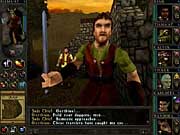
Of course, there's much more to Wizards & Warriors than just spells and swords. Actually, the game's title should be interpreted broadly, as your six characters can master over a dozen different professions. In addition, each character comes from one of ten different clans - effectively, races - and most of them are drastically different from one another.
Class Decisions
Initially, your characters are limited to one of four basic professions: warrior, wizard, rogue, or priest. But after earning enough experience and improving their bodies and minds, these characters may specialize and become one of several different subsets of each basic class. These specialized classes all retain the basic proficiencies of the original profession, but they also give the character new skills and abilities - generally, from one of the other four basic classes. For instance, a warrior may endeavor to become a paladin, who gains the ability to cast priest spells. Or the warrior might instead choose the path of the barbarian, an imposing fighter who has the rogue's ability to move swiftly and silently and even to disarm traps.
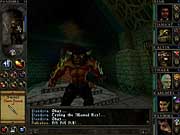
Wizards & Warriors offers you a chance to train your characters in virtually every traditional high-fantasy profession. Warlocks are powerful casters who are equally proficient at wizard spells and priest spells alike. Tricksters are essentially bards; they retain their original rogue abilities, but they are also able to learn some wizard spells - as well as use magical musical instruments in battle. Wizards & Warriors even offers your heroes a chance to specialize in certain Eastern professions as well - samurai are deadly swordsmen with knowledge of wizard magic, while ninjas are swift fighters who can also cast spells from the wizard school. There are over ten specialty classes available if you can meet the steep requisites for mastering their secret arts. Each specialty class also gives unique bonuses and skills. Some of these are very powerful, like soul drain, which heals the party member whenever he slays a monster; heroic legacy, which grants a bonus to all ability levels; crusade, which gives double experience for vanquishing undead enemies; and fury, which gives a percentage-chance to deal double damage. All the classes and skills ultimately give you a great deal of flexibility as you decide what sort of party would be best suited for vanquishing the pharaoh.
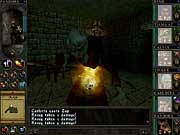
A mixed group of adventurers would ideally be able to contend with a diverse set of situations, and Wizards & Warriors certainly has no shortage of diversity for you to choose from. Your wizards and warriors can hail from ten different clans, including humans and typical fantasy races like elves and dwarves. But they can also originate from several other exotic species, such as ratlings - short, nimble, bipedal rodents; oomphaz - large, stocky, bipedal elephants; whiskas - slender, athletic, bipedal cats; gourks - rotund, powerful green-skinned creatures; lizzords - tall, scaly, bipedal lizards; and even diminutive, winged pixies. None of these clans are specifically restricted to particular professions, but certain clans are obviously better suited toward particular skills. For instance, ratlings make ideal rogues, although it's difficult to imagine a ratling trickster's singing voice; elves and whiskas are rather intelligent by nature - thus, they make good wizards; and gourks and lizzords are sturdy creatures that excel in combat. The quirky humor in Wizards & Warriors is most apparent in the different clans that you can choose from. You can create a rather unusual-looking party if you so choose, although you can also opt for a more conventional group of heroes.
Experience and Monsters
Your characters gain experience points as they defeat monsters and solve quests. Wizards & Warriors uses an experience system similar to that in second-edition Advanced Dungeons & Dragons, in that each time a character gains a level, he gets a small, random number of additional hit points. The character also gets slightly increased abilities, measured with a few bonus points that he can apply to any of his eight basic statistics. Specialty character classes all have statistical requisites that you'll have to meet before you can change classes - for instance, a barbarian needs a high "presence" statistic, which is similar to charisma in AD&D in that it affects how the character will be perceived by others. Gaining experience levels also grants your character additional skills. Characters can learn and master different weapons, including swords, staves, maces, axes, and daggers; they can also learn to use shields, thrown weapons, and bows. Soon enough, your warriors will be able to attack multiple times, even while using multiple weapons simultaneously.
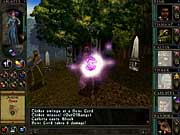
Meanwhile, your magic-using characters can specialize in different schools of magic. Wizards & Warriors features an unconventional magic system that offers six different schools of spells: sun, moon, stone, spirit, vine, and fiend. Priests begin with knowledge of spirit and vine schools, while Wizards know sun and stone magic by default. Magic-using classes can choose to increase their overall casting ability when they gain levels or can choose instead to heighten their mastery over one school in particular. Each school is self-contained; for example, a wizard who depletes his surplus of sun-magic spells might still have plenty of mana in reserve for his stone spells. Within these unusual magic schools lies a fairly conventional variety of spells, including elemental attacks, combat boosts, healing and regenerative abilities, and more.

You'll need all these spells to fend aside the various evil creatures that have inhabited Gael Serran. There are more than 75 unique 3D monster models in Wizards & Warriors, and well more than 300 monsters overall. These range from ghosts and zombies and thieves and pirates to demons and dragons. There are plenty of unique and bizarre monsters in the lineup as well. Between your own six characters and the packs of monsters you'll fight, it might sound as though it were a problem to have to manage such big fights in real time. Fortunately, Wizards & Warriors introduces an optional phased-time combat system that can automatically pause the action whenever it's your turn. This system is different from the recent batch of Might and Magic games by New World Computing, as well as Infinity Engine games like Baldur's Gate by BioWare and Icewind Dale by Black Isle Studios, which let you toggle between real-time and turn-based play at will. Essentially, Wizards & Warriors dynamically and seamlessly toggles the turn-based mode for you, making combat more fluid.
To further improve its gameplay, Wizards & Warriors actually moves very quickly. Your characters travel fast, and combat can be resolved without delay. Although Wizards & Warriors is a very long game, it's not because you'll spend huge amounts of time waiting between turns or traveling through barren wilderness. If anything, there appears to be rarely a dull moment in the game - monsters seem to spawn regularly, forcing you to always be on your guard. The game is loosely structured so that there will always be plenty of outlying areas to explore and peripheral quests to accept and accomplish; and there will be plenty of treasure and magic equipment to provide a suitable reward for your efforts.
The Long Way Home
Wizards & Warriors has an epic scope and plenty of content. However, its four long years in development may also prove to be one of the game's more noticeable shortcomings - the game's 3D graphics are creative and colorful, but not necessarily state-of-the-art. Its interface is serviceable, but not necessarily as neat and intuitive as possible. But most of all, Wizards & Warriors has an antiquated style. As in many first-person role-playing games from the '80s and early '90s - as well as second-edition AD&D - progress in Wizards & Warriors can be slow, and mistakes can be very punishing. Your characters may die easily, either at the hands of their enemies or through their own folly. Their equipment wears down, and each member even has his own personal supply of wealth. While Wizards & Warriors has plenty of story and plenty of nonplayer characters to interact with, the biggest portions of it consist of enemy-infested dungeon crawls, treasures, secret passageways, and other such role-playing trademarks.
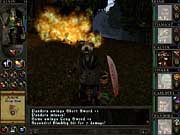
Three recent hit role-playing games, Activision's Vampire: The Masquerade, Blizzard's Diablo II, and Interplay's Icewind Dale, collectively proved that the general public is not only interested in role-playing games, but also particularly in action-packed role-playing games. Wizards & Warriors will certainly have plenty of action to go around - but its deep character-building system and its open-ended, much less linear structure may possibly prove to be a detriment rather than an asset when the game is finally released this fall. Like all games that have been in development for so long, Wizards & Warriors has a lot to live up to - especially since it's the spiritual successor to the classic Wizardry series, whose eighth installment went on hiatus when its publisher Sir-tech went out of business. In any case, the burgeoning market for computer role-playing games may just as easily predispose fans of the genre to this involving style of play.
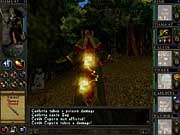
But at the same time, fierce competition from forthcoming games such as Baldur's Gate II: The Shadows of Amn and Pool of Radiance: The Ruins of Myth Drannor may overwhelm Wizards & Warriors. D.W. Bradley is not intimidated: Reflecting on Wizards & Warriors' upcoming competition, he says, "It's too much work, too much money, and too much time to develop something that has little or no appeal and will be soon forgotten." Certainly, a lot of work and a lot of time went into his game - and a lot of money as well, considering it went through several publishers and two name changes. Even so, D.W. Bradley believes that the appeal of Wizards & Warriors has remained constant and singular throughout the chaos - he's always sought "to make the experience as believable and as entertaining and challenging, as if it were really happening." This is the ultimate intent of every great role-playing game, and when the game is finally released this fall, you'll find out for sure whether Wizards & Warriors achieved it.
Got a news tip or want to contact us directly? Email news@gamespot.com
Join the conversation